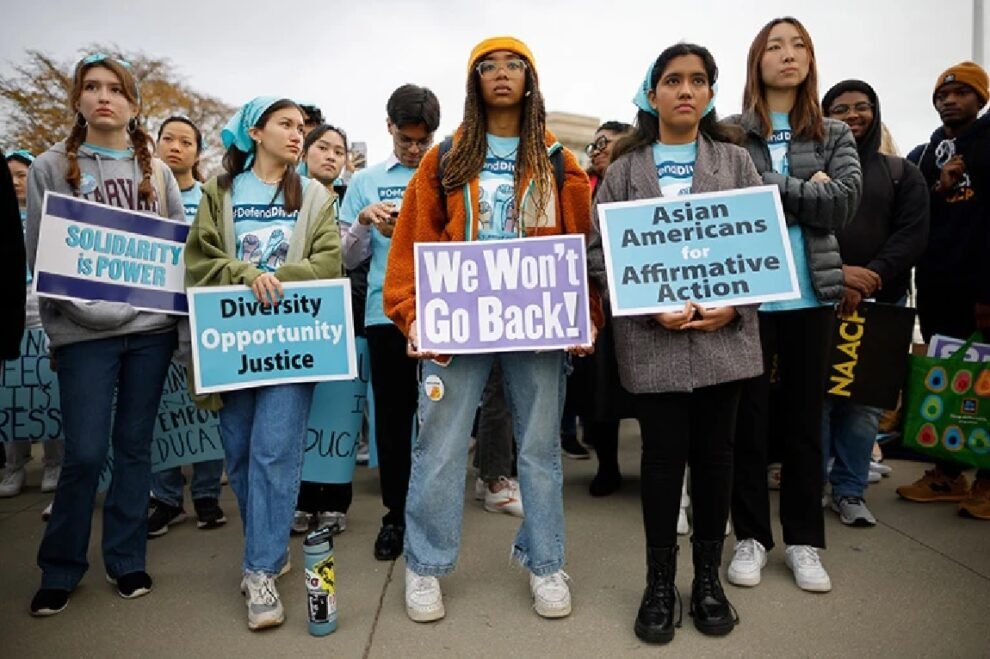The US Supreme Court has struck down colleges’ and universities’ right to use race as a factor in deciding which students they admit. Researchers say this will stymie efforts to increase the number of Black and Hispanic students, and others in minority-ethnic groups, at US academic institutions and could reduce diversity among workers in sectors such as science.
Not every college or university in the United States uses race-conscious admissions to shape its student body — some states, including California, Michigan and Florida, have banned the practice at public institutions. US institutions that are still using it have been doing so under the protection of a 2003 Supreme Court decision in the case Grutter v. Bollinger, which stated that it is constitutional for a university to consider race, alongside grades, test scores and other factors, in admissions to increase diversity on campus. But the 29 June decision says that the institutions at the centre of the newly decided case do not comply with limits on race-based admissions outlined in Grutter v. Bollinger.
The reason that some US universities have adopted race-conscious admissions — sometimes referred to as affirmative action — is to address centuries of racism and exclusion in the United States. These issues continue today and make it more difficult for people in minority ethnic groups to be admitted to academic institutions.
Researchers point to a 2020 study1 of 19 public universities in states that banned race-conscious admissions as a harbinger of what comes next: despite the fact that the percentages of under-represented minorities attending high school in those states rose after the bans, the universities admitted a smaller proportion of Black, Hispanic and Native American students. At the University of California, Los Angeles (UCLA), and UC Berkeley, the number of Black first-year students admitted in 1998 — the first year in which California’s ban was enforced — dropped by 43% and 66%, respectively.
The court’s decision will mostly affect elite institutions that turn down many of their applicants — which can be very expensive to attend, says Stella Flores, an education researcher at the University of Texas at Austin, who studies the impact of state and federal policies on college access. “Affirmative action was the only tool that helped us bring in students that weren’t from wealthy families or wealthy institutions,” Flores says. “It certainly isn’t a cure-all, but if you remove it, you remove the last bridge to some form of opportunity for everyone.”
Sweeping effects
The court issued its decision in response to two cases — one against Harvard University in Cambridge, Massachusetts, and the other against the University of North Carolina (UNC) in Chapel Hill — brought by the organization Students for Fair Admissions (SFFA). Created by activist Edward Blum, the group argued that, by considering race in their admissions process, both universities were discriminating against certain applicants, including Asian Americans.
Universities “have concluded, wrongly, that the touchstone of an individual’s identity is not challenges bested, skills built, or lessons learned but the color of their skin”, Chief Justice John Roberts wrote for the majority. “Our constitutional history does not tolerate that choice.”
The 6-3 ruling, split on ideological lines, reflects the court’s rightward turn under Republican President Donald Trump, who appointed three justices to the nine-person bench.
This decision will not only have sweeping effects on the composition of student bodies, but it could also affect the make-up of staff, says Julie Park, a researcher at the University of Maryland in College Park, whose work focuses on racial equality in higher education. “For better or for worse, these elite or name-brand institutions are a big part of the pathway into the professoriate,” Park says.
For instance, a study published last September in Nature2 found that just 20% of institutions that grant PhDs in the United States supplied 80% of tenure-track faculty members across the country from 2011 to 2020. These institutions include Harvard University and Stanford University in California, but the list does not have any historically Black colleges and universities or Hispanic-serving institutions.
Without race-conscious admissions, the diversity of future generations of scientists, who are trained at universities, might suffer too, Park says. Black and Hispanic workers are already under-represented in science, technology, engineering and mathematics (STEM), making up only 9% and 8%, respectively, of the total STEM workforce in the United States, according to a report by the Pew Research Center in Washington DC. (Black people make up around 14% of the US population, and Hispanic people account for nearly 19%.) “I am very concerned, because STEM hasn’t been doing so great, even with race-conscious admission policies in place,” Park says.
Alternative methods
Some institutions might now seek other ways to make their student populations more diverse, says Timothy Welbeck, a civil-rights attorney and scholar of law, race, and cultural studies at Temple University in Philadelphia, Pennsylvania. This will cost a lot of money, and require universities to better understand how members of under-represented groups — especially those who don’t come from wealthy families — decide where to attend, Flores says. And there’s no guarantee that other methods will yield a diverse student body: the UC system has tried, and mostly failed, for decades to replace race-conscious admissions.
In a brief it filed with the Supreme Court ahead of the Harvard and UNC Chapel Hill cases, the UC system said that it has tried outreach programmes and other holistic admissions policies, but that it has struggled to meet its goals, admitting that, perhaps, “highly competitive universities may not be able to achieve the benefits of student body diversity through race-neutral measures alone”.
Other steps that elite colleges could take, specialists say, are to end legacy admissions, which give students a leg up if they have alumni family members, and to no longer require standardized testing, which some students prepare for by attending costly classes. Both practices have been shown3 to favour white, wealthy applicants.
“The attacks on affirmative action are really attacks against efforts to remedy past harm against Black people,” Welbeck says. “So, affirmative action is just another data point in that line of a historical trend.”
Source : Nature












